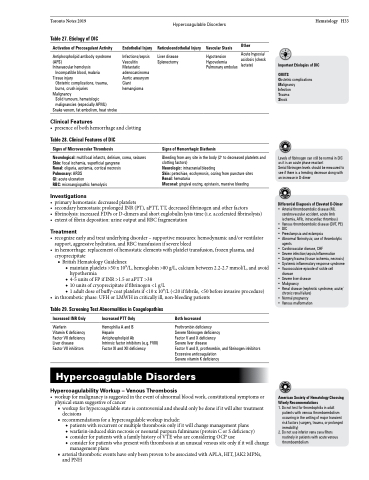Page 573 - TNFlipTest
P. 573
Toronto Notes 2019
Hypercoagulable Disorders
Hematology H33
Table 27. Etiology of DIC
Activation of Procoagulant Activity
Antiphospholipid antibody syndrome (APS)
Intravascular hemolysis
Incompatible blood, malaria Tissue injury
Obstetric complications, trauma,
burns, crush injuries Malignancy
Solid tumours, hematologic
malignancies (especially APML) Snake venom, fat embolism, heat stroke
Clinical Features
Endothelial Injury
Infections/sepsis Vasculitis Metastatic adenocarcinoma Aortic aneurysm Giant hemangioma
Reticuloendothelial Injury
Liver disease Splenectomy
Vascular Stasis
Hypotension Hypovolemia Pulmonary embolus
Other
Acute hypoxia/ acidosis (check lactate)
Important Etiologies of DIC
OMITS
Obstetric complications Malignancy
Infection
Trauma
Shock
Levels of fibrinogen can still be normal in DIC as it is an acute phase reactant
Serial fibrinogen levels should be measured to see if there is a trending decrease along with an increase in D-dimer
Differential Diagnosis of Elevated D-Dimer
• Arterial thromboembolic disease (MI, cerebrovascular accident, acute limb ischemia, AFib, intracardiac thrombus)
• Venous thromboembolic disease (DVT, PE) • DIC
• Preeclampsia and eclampsia
• Abnormal fibrinolysis; use of thrombolytic
agents
• Cardiovascular disease, CHF
• Severe infection/sepsis/inflammation
• Surgery/trauma (tissue ischemia, necrosis) • Systemic inflammatory response syndrome • Vasoocculsive episode of sickle cell
disease
• Severe liver disease
• Malignancy
• Renal disease (nephrotic syndrome, acute/
chronic renal failure) • Normal pregnancy
• Venous malformation
• presenceofbothhemorrhageandclotting
Table 28. Clinical Features of DIC Signs of Microvascular Thrombosis
Neurological: multifocal infarcts, delirium, coma, seizures Skin: focal ischemia, superficial gangrene
Renal: oliguria, azotemia, cortical necrosis
Pulmonary: ARDS
GI: acute ulceration
RBC: microangiopathic hemolysis
Investigations
Signs of Hemorrhagic Diathesis
Bleeding from any site in the body (2o to decreased platelets and clotting factors)
Neurologic: intracranial bleeding
Skin: petechiae, ecchymosis, oozing from puncture sites
Renal: hematuria
Mucosal: gingival oozing, epistaxis, massive bleeding
• primaryhemostasis:decreasedplatelets
• secondaryhemostasis:prolongedINR(PT),aPTT,TT,decreasedfibrinogenandotherfactors
• fibrinolysis:increasedFDPsorD-dimersandshorteuglobulinlysistime(i.e.acceleratedfibrinolysis) • extentoffibrindeposition:urineoutputandRBCfragmentation
Treatment
• recognizeearlyandtreatunderlyingdisorder–supportivemeasures:hemodynamicand/orventilator support, aggressive hydration, and RBC transfusion if severe bleed
• inhemorrhage:replacementofhemostaticelementswithplatelettransfusion,frozenplasma,and cryoprecipitate
■ British Hematology Guidelines:
◆ maintain platelets >50 x 109/L, hemoglobin >80 g/L, calcium between 2.2-2.7 mmol/L, and avoid
hypothermia
◆ 4-5 units of FP if INR >1.5 or aPTT >38
◆ 10 units of cryoprecipitate if fibrinogen <1 g/L
◆ 1 adult dose of buffy-coat platelets if <10 x 109/L (<20 if febrile, <50 before invasive procedure)
• in thrombotic phase: UFH or LMWH in critically ill, non-bleeding patients
Table 29. Screening Test Abnormalities in Coagulopathies
Increased INR Only
Warfarin
Vitamin K deficiency Factor VII deficiency Liver disease
Factor VII inhibitors
Increased PTT Only
Hemophilia A and B
Heparin
Antiphospholipid Ab
Intrinsic factor inhibitors (e.g. FVIII) Factor XI and XII deficiency
Both Increased
Prothrombin deficiency
Severe fibrinogen deficiency
Factor V and X deficiency
Severe liver disease
Factor V and X, prothrombin, and fibrinogen inhibitors Excessive anticoagulation
Severe vitamin K deficiency
Hypercoagulable Disorders
Hypercoagulability Workup – Venous Thrombosis
• workupformalignancyissuggestedintheeventofabnormalbloodwork,constitutionalsymptomsor physical exam suggestive of cancer
■ workup for hypercoagulable state is controversial and should only be done if it will alter treatment decisions
■ recommendations for a hypercoagulable workup include:
◆ patients with recurrent or multiple thrombosis only if it will change management plans
◆ warfarin-induced skin necrosis or neonatal purpura fulminans (protein C or S deficiency)
◆ consider for patients with a family history of VTE who are considering OCP use
◆ consider for patients who present with thrombosis at an unusual venous site only if it will change
management plans
■ arterial thrombotic events have only been proven to be associated with APLA, HIT, JAK2 MPNs,
AmericanSocietyofHematologyChoosing Wisely Recommendations
1. Do not test for thrombophilia in adult
patients with venous thromboembolism occurring in the setting of major transient risk factors (surgery, trauma, or prolonged immobility)
2. Do not use inferior vena cava filters routinely in patients with acute venous thromboembolism
and PNH


